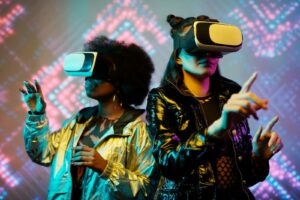In today’s fast-paced digital landscape, where innovation is the driving force, Augmented Reality (AR) and Virtual Reality (VR) have emerged as two remarkable technologies that are reshaping the way we interact with content. With the potential to revolutionize various industries, from gaming and entertainment to education and marketing, Augmented Reality and Virtual Reality in content are no longer just buzzwords; they are powerful tools that are changing the dynamics of content consumption. In this comprehensive article, we delve deep into the world of AR and VR, exploring their applications, benefits, challenges, and how they are transforming the content landscape.
The Rise of AR and VR: A Paradigm Shift in Content Interaction
Augmented Reality (AR) and Virtual Reality (VR) are two distinct yet interconnected technologies that alter our perception of reality. AR enhances the real-world environment by overlaying digital elements, such as images, videos, or text, onto it. On the other hand, VR immerses users in a completely synthetic environment, shutting out the physical world. These technologies have garnered significant attention due to their potential to create engaging and interactive experiences.

Evolution and Adoption
AR and VR have evolved significantly from their initial applications in the gaming industry. They are now finding applications in diverse fields, such as education, healthcare, retail, and architecture. The rise of smartphones equipped with sophisticated sensors and cameras has driven the adoption of AR technology, making it accessible to a broader audience. VR, on the other hand, often requires specialized hardware like headsets, which have become more advanced and affordable over time.
Advantages of Augmented Reality and Virtual Reality in Content
The utilization of AR and VR presents a transformative shift in content engagement. By seamlessly merging digital elements with reality, AR captivates users, while VR transports them to new realms of exploration. Moreover, these technologies excel in visualizing real-world scenarios and enhancing data exploration, making them indispensable tools across industries.
Enhanced Engagement and Interactivity
AR and VR offer unparalleled levels of engagement and interactivity. By seamlessly blending digital content with the real world, AR creates immersive experiences that capture users’ attention. VR, on the other hand, transports users to entirely new environments, allowing them to explore and interact with content in ways previously unimaginable.
Visualizing and Simulating Real-World Scenarios
One of the key strengths of AR and VR is their ability to visualize and simulate real-world scenarios. In industries like architecture and interior design, AR can overlay virtual models onto physical spaces, enabling clients to visualize how a space will look after construction. Similarly, VR can provide immersive training simulations for industries like aviation and medicine, where hands-on experience is crucial.
Data Visualization and Exploration
AR and VR enable the visualization of complex data sets. In scientific research or business analytics, these technologies can transform raw data into interactive 3D visualizations, allowing users to gain deeper insights and make informed decisions. For instance, an architect could use AR to visualize energy flow within a building’s design, while a financial analyst could use VR to explore market trends in a virtual environment.
AR and VR stand as catalysts for innovation, revolutionizing how we engage with content and conceptualize the world around us. Their immersive capabilities not only enhance user experiences but also empower industries to visualize, simulate, and analyze with unprecedented depth and accuracy. As we embrace the boundless potential of AR and VR, the horizon of possibilities expands infinitely.
Applications of AR and VR in Different Industries
AR and VR technologies are reshaping various industries, enhancing experiences and pushing boundaries. In education, they bring history to life and enable immersive biology lessons. Healthcare benefits from simulated surgeries and therapeutic environments. Real estate embraces virtual walkthroughs, while entertainment thrives on immersive gaming experiences. Marketing sees heightened engagement through interactive campaigns. The possibilities are endless, revolutionizing how we learn, heal, design, entertain, and engage with brands.
Education: Transforming Learning Experiences
The education sector has embraced AR and VR to revolutionize traditional learning methods. AR brings textbooks to life by adding interactive elements like 3D models and animations. Imagine a history lesson where students can virtually visit ancient civilizations or a biology class where they can dissect virtual organisms. VR takes learning even further by transporting students to historical events, remote locations, or inside the human body for an immersive educational experience.
Healthcare: Training and Therapy
In the healthcare industry, AR and VR are proving to be invaluable tools for training and therapy. Medical students can practice surgeries in a risk-free VR environment before entering the operating room. AR aids surgeons by overlaying vital information on the patient’s body during procedures. Additionally, VR is used for pain management and exposure therapy, where patients can confront and overcome their fears in controlled virtual settings.
Real Estate and Architecture: Envisioning Spaces
The real estate and architecture sectors leverage AR and VR to transform the way properties are presented and designed. With AR, potential buyers can use their smartphones to view interactive 3D models of properties, visualizing furniture placements and renovations. VR enables architects to create virtual walkthroughs of unbuilt structures, allowing clients to experience the space before construction begins.
Entertainment and Gaming: Immersive Worlds
Entertainment has witnessed a paradigm shift with the integration of AR and VR. AR-powered mobile games like Pokémon GO have taken the world by storm, merging virtual creatures with the real environment. VR gaming immerses players in lifelike environments, where they can interact with characters and objects in three dimensions. This technology has paved the way for entirely new forms of storytelling and gameplay.
Marketing and Advertising: Enhanced Engagement
AR and VR are transforming the marketing landscape by enabling brands to create highly engaging and interactive campaigns. AR allows customers to “try on” products virtually before making a purchase decision. Imagine trying out different shades of makeup or placing virtual furniture in your living room. VR marketing campaigns can transport users to branded virtual worlds, forging a deeper emotional connection with the brand.
AR and VR are not just technologies; they are gateways to new realms of experience and connection, shaping the future of industries and human interaction.
Challenges and Considerations
The advancement of Augmented Reality (AR) and Virtual Reality (VR) technologies offers immense potential, yet they confront several formidable challenges. Technical hurdles persist, with AR’s real-time content overlay requiring sophisticated algorithms, and VR facing motion sickness issues. Content creation complexity demands specialized skills and tools, leading to higher costs and prolonged development timelines. Moreover, hardware limitations, particularly in VR, and privacy concerns further impede widespread adoption.
Technical Challenges
Despite their potential, AR and VR still face technical challenges that can hinder widespread adoption. For AR, accurately overlaying digital content onto the real world in real-time requires sophisticated computer vision and tracking algorithms. VR faces challenges related to motion sickness, where users can experience discomfort due to the perceptual mismatch between their visual and physical senses.
Content Creation Complexity
Creating compelling AR and VR experiences demands specialized skills and tools. Content creators need to design for different perspectives and interactions, considering how users will interact with digital elements in a 3D space. This complexity can result in higher production costs and longer development timelines compared to traditional 2D content.
Hardware Limitations
VR hardware, particularly high-quality headsets, can be costly, limiting accessibility for some users. Additionally, the need for powerful computing hardware to run VR experiences smoothly can further increase the overall cost of adoption. AR, while more accessible through smartphones, still relies on the capabilities of the device’s camera and sensors.
Privacy and Ethical Concerns
AR and VR raise significant privacy concerns, especially regarding data collection and surveillance. AR apps that use location data or personal information need robust privacy measures to protect user data. VR experiences that track user movements and interactions within the virtual environment also raise ethical questions about consent and data security.
As AR and VR continue to evolve, addressing these challenges will be paramount in unlocking their full potential, ensuring accessibility, safeguarding privacy, and fostering ethical use in our increasingly digital world.
The Future of AR and VR in Content
The future of AR and VR in content is promising, with technology advancing at an astonishing pace. As hardware becomes more powerful and affordable, we can expect wider adoption and integration of AR and VR across industries. Content creation tools will likely evolve to become more user-friendly, enabling a broader range of creators to develop immersive experiences. The convergence of AR and VR with other technologies like artificial intelligence and 5G connectivity will open up new avenues for innovation.
The convergence of AR and VR with other technologies like artificial intelligence and 5G connectivity will open up new avenues for innovation. This integration will enhance the capabilities of AR and VR experiences, making them more interactive, responsive, and personalized to user preferences. Additionally, advancements in spatial computing and haptic feedback will further blur the lines between physical and virtual worlds, offering unparalleled levels of immersion. As these technologies mature, we can anticipate transformative changes in entertainment, education, healthcare, manufacturing, and beyond.
Conclusion
Augmented Reality and Virtual Reality in content are ushering in a new era of content interaction, offering immersive experiences that engage, educate, and entertain users across industries. From enhancing education and transforming healthcare to reshaping marketing and entertainment, AR and VR are leaving an indelible mark on how we perceive and interact with content. While challenges like technical complexities and privacy concerns persist, the continuous evolution of technology promises a future where AR and VR are seamlessly integrated into our daily lives, enriching the way we experience the digital realm. As we embark on this transformative journey, the fusion of real and virtual worlds holds the potential to create a more connected and immersive reality.
FAQs
What is the difference between Augmented Reality (AR) and Virtual Reality (VR)?
Augmented Reality (AR) overlays digital content onto the real world, enhancing the environment with additional information. Virtual Reality (VR) creates a completely immersive experience by transporting users to a synthetic environment, shutting out the physical world.
How are AR and VR used in education?
In education, AR and VR offer immersive learning experiences. AR enhances textbooks with interactive elements, while VR transports students to historical events or remote locations, providing engaging and memorable educational content.
What industries benefit the most from AR and VR?
AR and VR have applications in various industries. They are transforming education, healthcare, real estate, entertainment, marketing, and more by providing interactive and engaging experiences.
Are there any challenges associated with AR and VR adoption?
Yes, there are challenges such as technical complexities, content creation demands, hardware limitations, and privacy concerns. These challenges need to be addressed for widespread adoption.
What does the future hold for AR and VR in content?
The future is promising, with advancing technology leading to wider adoption. As hardware becomes more affordable, AR and VR will likely become integral parts of content creation and consumption across industries.




